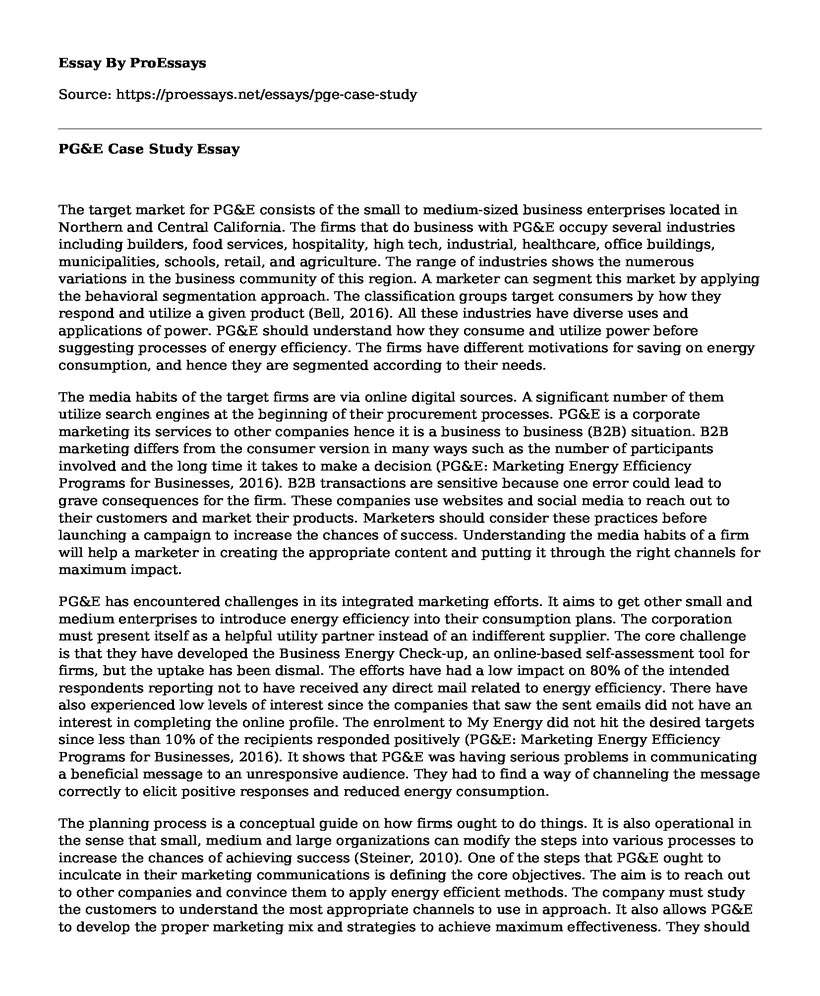The target market for PG&E consists of the small to medium-sized business enterprises located in Northern and Central California. The firms that do business with PG&E occupy several industries including builders, food services, hospitality, high tech, industrial, healthcare, office buildings, municipalities, schools, retail, and agriculture. The range of industries shows the numerous variations in the business community of this region. A marketer can segment this market by applying the behavioral segmentation approach. The classification groups target consumers by how they respond and utilize a given product (Bell, 2016). All these industries have diverse uses and applications of power. PG&E should understand how they consume and utilize power before suggesting processes of energy efficiency. The firms have different motivations for saving on energy consumption, and hence they are segmented according to their needs.
The media habits of the target firms are via online digital sources. A significant number of them utilize search engines at the beginning of their procurement processes. PG&E is a corporate marketing its services to other companies hence it is a business to business (B2B) situation. B2B marketing differs from the consumer version in many ways such as the number of participants involved and the long time it takes to make a decision (PG&E: Marketing Energy Efficiency Programs for Businesses, 2016). B2B transactions are sensitive because one error could lead to grave consequences for the firm. These companies use websites and social media to reach out to their customers and market their products. Marketers should consider these practices before launching a campaign to increase the chances of success. Understanding the media habits of a firm will help a marketer in creating the appropriate content and putting it through the right channels for maximum impact.
PG&E has encountered challenges in its integrated marketing efforts. It aims to get other small and medium enterprises to introduce energy efficiency into their consumption plans. The corporation must present itself as a helpful utility partner instead of an indifferent supplier. The core challenge is that they have developed the Business Energy Check-up, an online-based self-assessment tool for firms, but the uptake has been dismal. The efforts have had a low impact on 80% of the intended respondents reporting not to have received any direct mail related to energy efficiency. There have also experienced low levels of interest since the companies that saw the sent emails did not have an interest in completing the online profile. The enrolment to My Energy did not hit the desired targets since less than 10% of the recipients responded positively (PG&E: Marketing Energy Efficiency Programs for Businesses, 2016). It shows that PG&E was having serious problems in communicating a beneficial message to an unresponsive audience. They had to find a way of channeling the message correctly to elicit positive responses and reduced energy consumption.
The planning process is a conceptual guide on how firms ought to do things. It is also operational in the sense that small, medium and large organizations can modify the steps into various processes to increase the chances of achieving success (Steiner, 2010). One of the steps that PG&E ought to inculcate in their marketing communications is defining the core objectives. The aim is to reach out to other companies and convince them to apply energy efficient methods. The company must study the customers to understand the most appropriate channels to use in approach. It also allows PG&E to develop the proper marketing mix and strategies to achieve maximum effectiveness. They should also incorporate the step of determining appropriate resources since PG&G must evaluate everything they require to reach out to the other companies.
References
Bell, E. (2016). Customer Segmentation: 5 Ways to Divide the Consumer Base. BRIDGE MARKETING. Retrieved 15 March 2018, from http://www.thebridgecorp.com/customer-segmentation/PG&E: Marketing Energy Efficiency Programs for Businesses. (2016).
Steiner, G. (2010). Strategic Planning. New York: Simon and Schuster.
Cite this page
PG&E Case Study. (2022, Apr 04). Retrieved from https://proessays.net/essays/pge-case-study
If you are the original author of this essay and no longer wish to have it published on the ProEssays website, please click below to request its removal:
- Non-Disclosure Agreements
- Marketing Strategy of Health Cafe
- Advice to MB on the Potential Liability to the Unfair Dismissal
- Move Baladna Company That Qatar Brand to UK Foreign Market
- Essay Sample on Principles of Food and Beverage Service Management Changes
- Research Paper Example on Organizational Structure: Key to Achieving Competitive Advantage
- Business Plan - Free Sample







